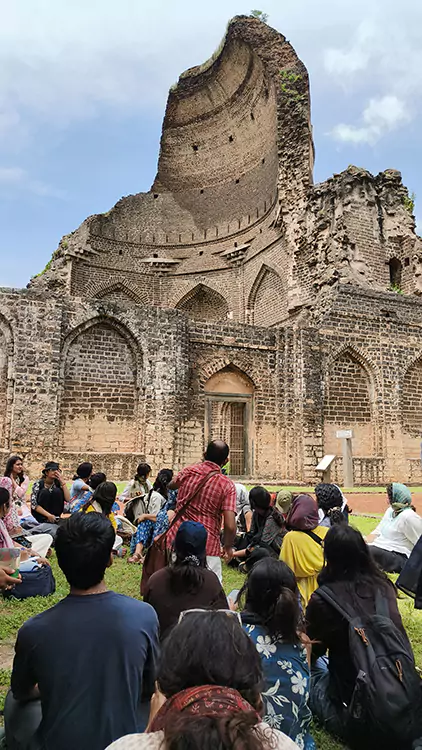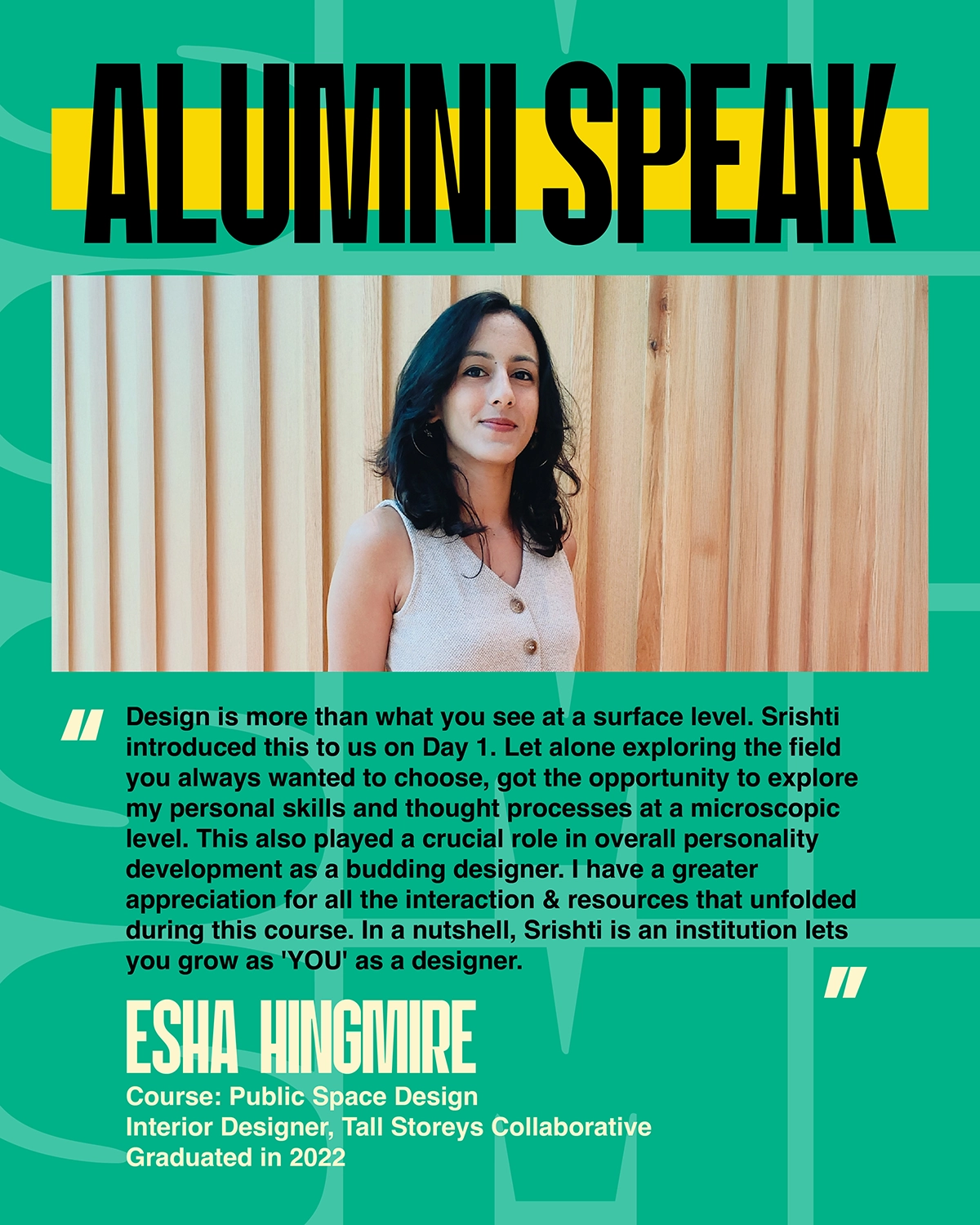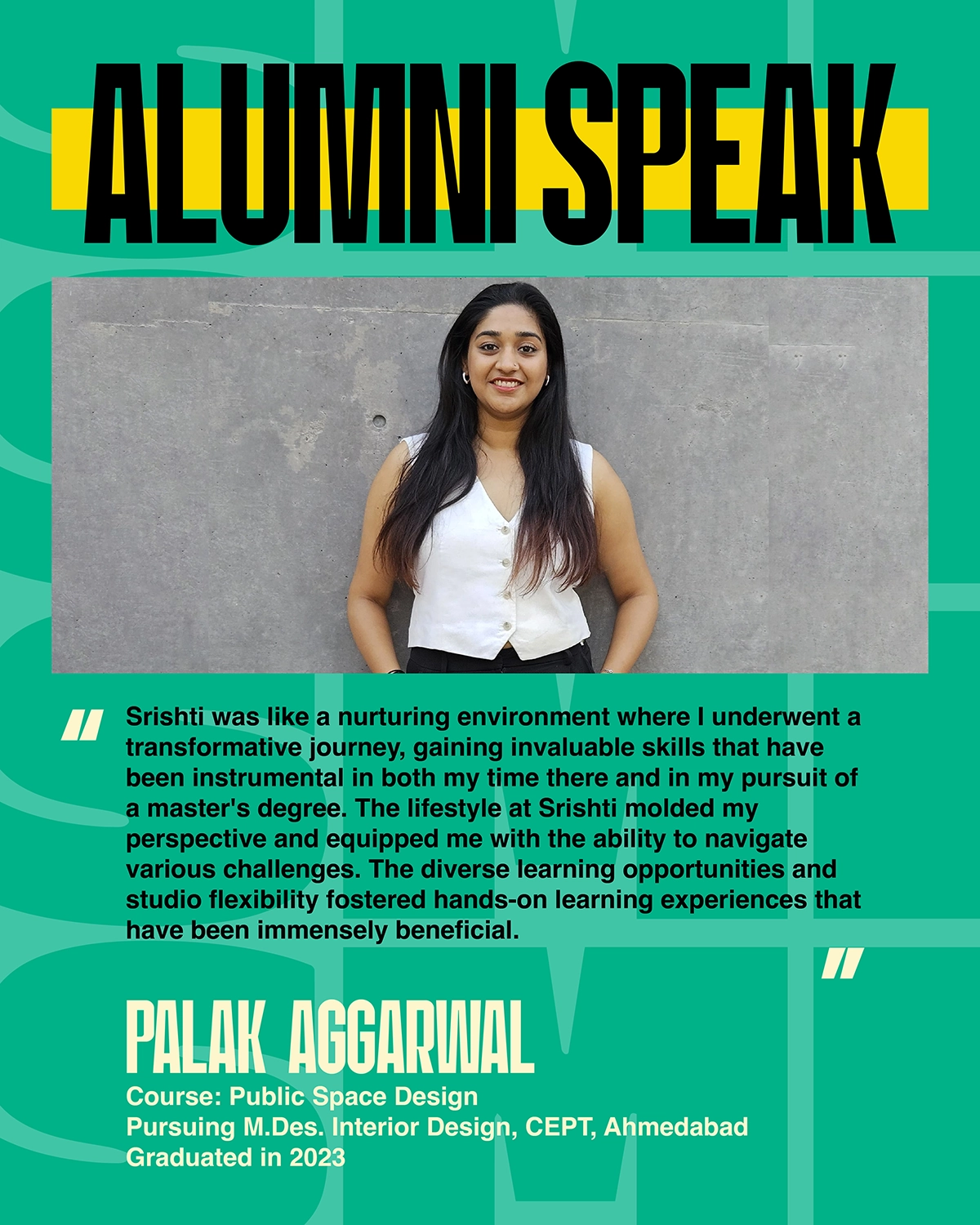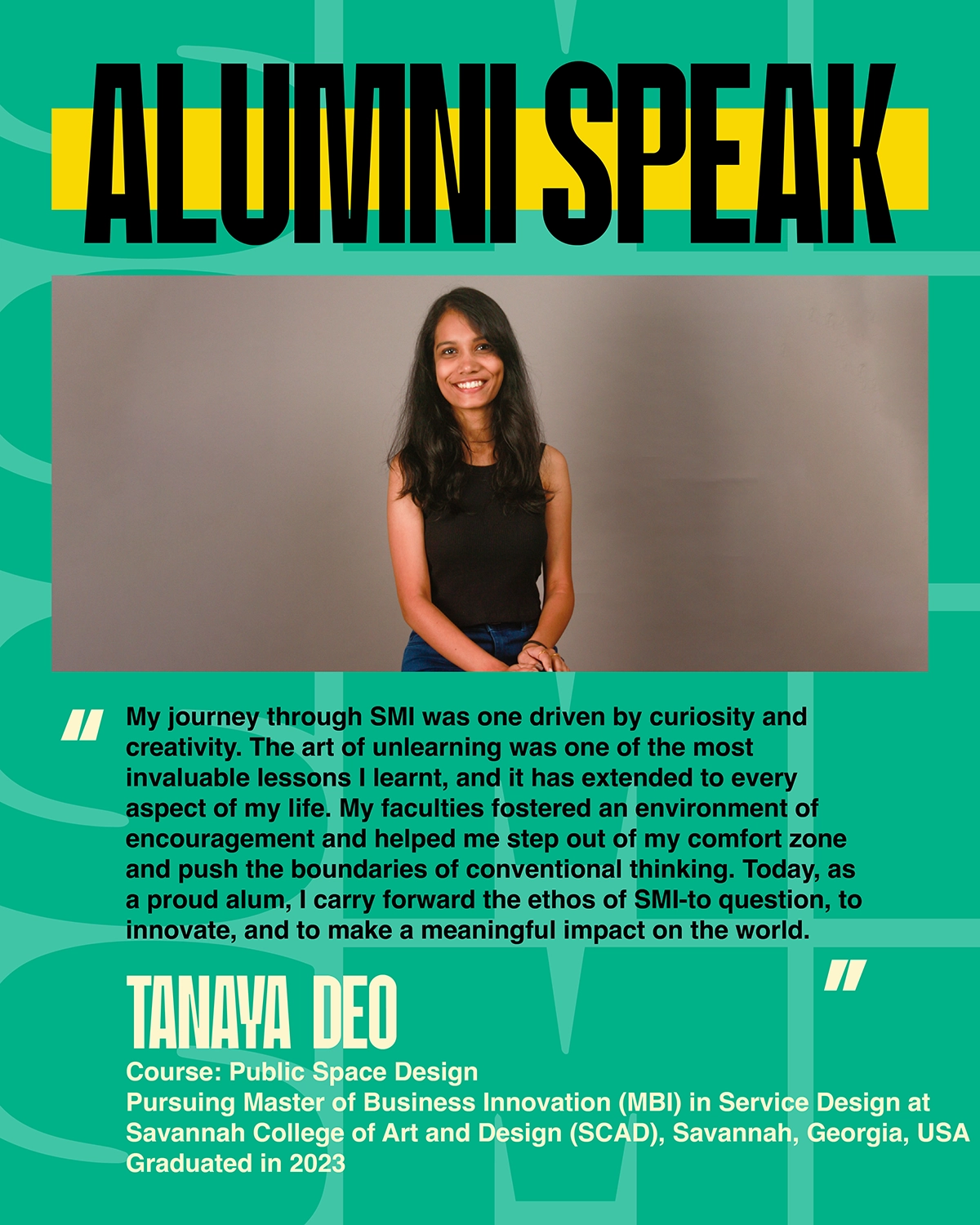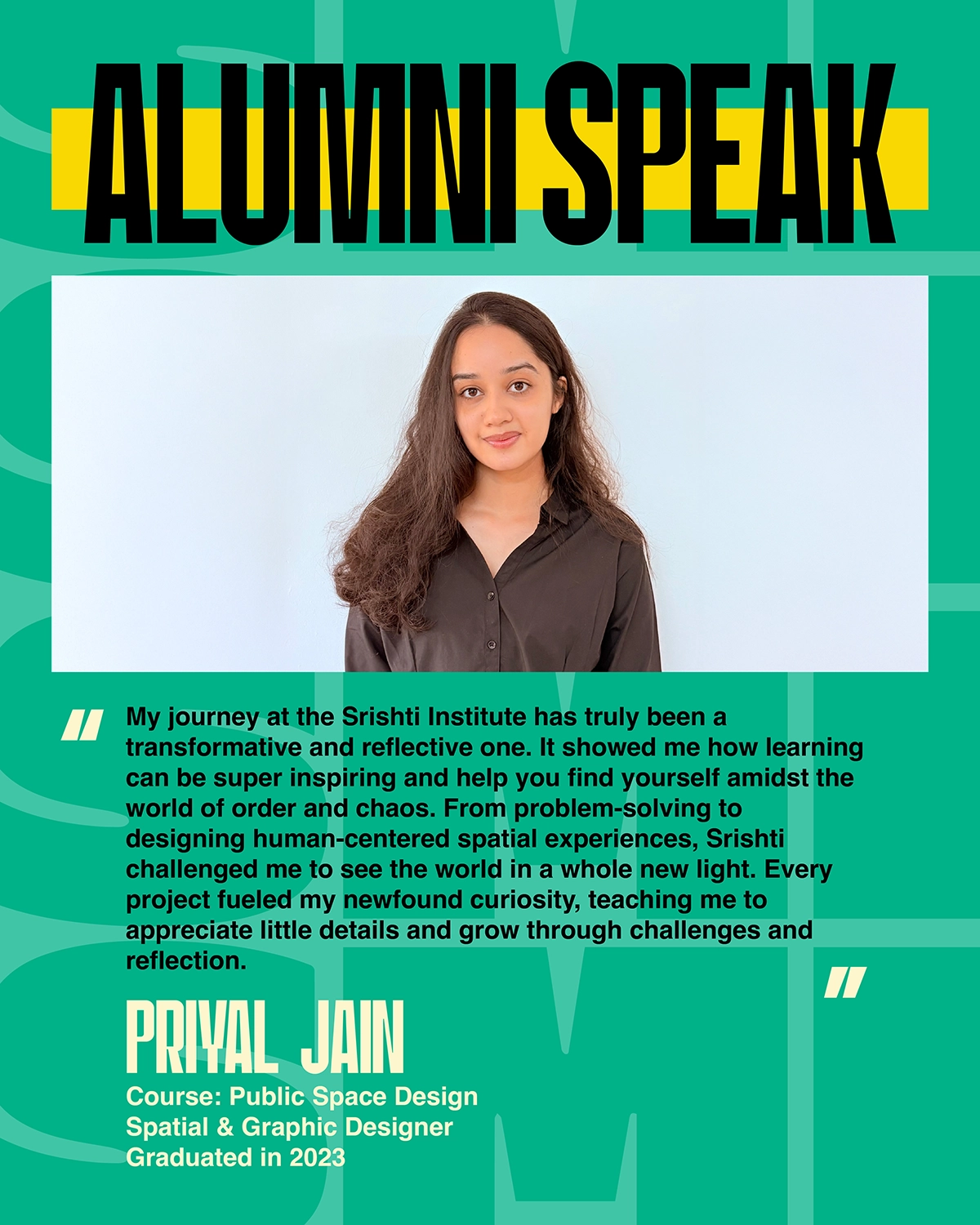4-YEAR UG Professional Program
Spatial Design*

Course Overview
The Spatial Design course at Srishti Manipal Institute invites creative individuals interested in crafting meaningful spaces, imagining reconfigurable interior spaces of future, curating exhibition spaces & immersive experiences, facilitating community commons, and investigating the everyday urban.
During the four-year student journey, an array of modules offers fundamentals of spatial thinking, physical & perceptional sensibilities, shaping space-human interactions, material intelligence, and spatial communication, etc. Real-world immersions, field visits, and critical discussions encourage context-sensitive, locally relevant, and environmentally responsible spatial design interventions.
Rooted in SMI’s interdisciplinary ethos, the course critically explores the idea of ‘space’—not merely as a physical construct but as a medium shaped by human experience, culture, and context. The learner’s understanding of space design & experiences is enriched from diverse perspectives from furniture and product design, communication design, curatorial and artistic practice, service and systems design, and community collaborations that SMI’s rich ecosystem offers.
The course prepares aspiring practitioners to navigate diverse future faced spatial design practices spanning interior design, exhibition and production design, spatial curation of experiential and immersive environments, facilitation of community and public spaces, urban research and strategy, and artistic engagements with the everyday urban. It envisions spatial design as an interdisciplinary practice to investigate, imagine, and transform spatial environments to enrich human experiences, inspire dialogue, foster belonging, and reimagine the everyday.
Course Focus
Leveraging on the interdisciplinary ecosystem of SMI, the course envisions spatial design as a critical practice and explores spatiality through Human Behavior & Psychology, Cultural Transformations, Community Engagement & Participation, Immersive Technologies and Advancements, Big Data & Systems Thinking, etc. The course dwells with ‘space’ as a 3-dimensional canvass which is perceived & appreciated in diverse forms such as tangible space, spatial experience, curation, design process to facilitate collaboration & participation, artistic expression, strategic mapping & intervention, etc. based on the context and focus of the studio offered. This approach benefits students to expand the dimension of space design beyond aesthetic and functional agenda and allows for critical thinking while enriching the students with skills that keep them ahead of the curve.
*This B.Des course previously titled ‘Public Space Design’ has been renamed Spatial Design to better reflect the broader scope, clarity in student learning, and stronger relevance to the design practices the course offers. This change of course title is currently pending final approval from AICTE, which is expected by February 2026.
LEVEL
Undergraduate Degree
AWARD
Bachelor of Design (B.Des)
DURATION
4 Years / Full-time
Round 1: Last Day to Apply
March 15, 2026
Core Values
Core Values:
- The graduate in Spatial Design is deeply humanist, is a critical thinker and has the creative confidence to navigate the interdisciplinary nature of design practice that they wish to pursue. The spatial Design course upholds the following values, which locate individual experience at center stage:
- Social Equity & Inclusion
- Cultural Sensitivity & Contextual Awareness
- Community Care & Empathy
- Ecological Consciousness
- Interdisciplinary Collaboration
For More information, please contact Ninad Koranne (Associate Professor) at ninad.koranne@manipal.edu
Course Structure
Course Structure:
The course comprises of foundation courses, studio based making and learning, critical reading and writing, internships, electives and project-based semesters.
- Foundation introduces students to basic principles and tools of Art, Design and Technology as methods, tools and processes.
- Disciplinary Studios are learning spaces where students develop core disciplinary capabilities, while navigating a trans-disciplinary environment
- General Studies is a common and compulsory programme of study that integrates Humanities, Sciences, Maths, business and finance. Development and Policy Studies and also offers Languages (Spanish, French and German)
- Interim is an immersive introduction to practice in new and emerging areas of art and design and environmental exposure
- Electives are of three kinds – this program allows students to expand their skills, develop the interests as well as provide opportunities for travel exchange
- Internship/Apprenticeship is compulsory work experience done over the summer-break between the 6th and 7th semester
- Project based learning involves the application and synthesis of capabilities acquired. Two projects, pre-thesis and thesis, is culmination of the 4-year undergraduate program, which allows for demonstration of an integration of values, positions, capabilities and practice.
Learning Approach
Learning Approach:
The core values are experienced through a range of interdisciplinary learning approaches:
- Driven by Enquiry through generative themes that are rooted around historical, socio-cultural and political contexts
- Studio Based Learning is encouraged, where students work in teams.
- Theoretical and Critical approach to expand the idea of art and design practice
- Hands-on approach to making for developing self-expression,
- Research and collaborations as ways to widen thought and dimensions of practice.
- Field based enquiry making the real-world into a classroom
- Participatory approach through direct engagement with communities of various practitioners.
Capabilities
Capability Set:
Upon successful completion of this course graduates will have developed the following capabilities:
To effectively design, visualize, communicate and represent spatial design concepts and ideas to a larger audience.
Iterating to translate a line of thinking into a desired form by drawing from one’s exposure to various practices, and to hone skill by repetitive use of certain tools.
To collaborate & co-design with communities to understand and design for their needs and well-being.
To work in professional environments with integrity and competence.
To understand, explore and creatively work with materials, services, and systems.
To understand complexities of multifaceted contexts and develop an integrated and comprehensive approach to design.
To be able to think critically through reflection and identify patterns to develop one’s practice independently.
FAQs
It is a multidisciplinary field that draws from architecture, interior design, urban design, and even experience design, and communication design, focusing on how people move through and interact with the built environments. By understanding the relationship between people and space, designers can create spaces or spatial interventions that are engaging, efficient, and supportive of their intended purpose. This leads to improved user experiences, enhanced community participation & interaction, and more sustainable, inclusive and adaptable environments.
Yes. The course, approaches interior design as future-facing space & practice where students are encouraged to imagine and create meaningful interior spaces and interventions that demand a shift from static, singular-use spaces to kinetic, fluid, adaptive & transformative spaces that will evolve with changing social, cultural and technological shifts, and are responsive to psychological, behavioral and experiential needs of the occupants. The course encourages students to design with flexibility, personalization, and emergent living patterns shaped by culture, memory, and technology.
The spatial design studio contexts are varied to respond to studio learning goals and capabilities. Depending on the studio intent, the contexts range from interior & community spaces, planned & unplanned spaces, temporary & permanent spaces across diverse scales ranging from chai points to cafes, neighbourhood shops to brand environments, every day meeting spaces to community centers, reading rooms to public libraries, from healthcare spaces to hospitality spaces, curatorial exhibition & thematic event spaces, creative mapping of everyday urban, to mention a few.
Spatial design course offered at SMI aligns strongly with ethos of interdisciplinary and inclusive design practice and pedagogy. The choice-based course navigation through the four-year learning at an undergraduate level, allows for student-centric learning and creative focus area navigation for a learner to develop their individual portfolio of practice. This course approaches spatial design beyond its formal, aesthetic and functional agenda but rather encourages critical thinking to engage with space as a platform or catalyst to respond to the social context and needs.
Creative individuals from all academic backgrounds who are passionate about shaping meaningful spaces, imagining reconfigurable spaces for future, curating immersive experiences, narrating stories through spatial interventions, and investigating the everyday urban would cherish the program offerings. Individuals with strong collaborative skills, critical thinking abilities and those who are interested in situating a practice that dwells in space design, place making, experience & stories, spatial curation, community and culture, Living Futures, and sustainable urban strategies, are welcome to apply.
Graduates from B. Des in Spatial Design are confident, agile and creative individuals that can navigate both professional and research inclined spatial design practices of their interests, including interior environments, interactive & experiential environments, community environments, urban environments, etc. Our graduates have been engaged in following professional practices.
- Spatial Planner & Designer in architecture, interior and furniture design studios
- Researcher & Spatial Strategist with leading design studios and think tanks, involved in envisioning speculative futures of space and experience.
- Exhibition & Spatial Experience Designer
- Production Designer for Immersive Events
- Facilitator for Place-making & Community building Initiatives
- Artistic Practitioner for Public Art, Activism and Agency
- Community consultation, user experience & Design research
- Urban Researchers & Strategist with Urban Think Tanks & Action Groups
- Development sector opportunities with government and government-allied agencies, consultancy and advocacy firms working in the urban or rural sector such as street (re)design, public space (re)design, community commons, etc.
Academic & Research Practice:
The course also equips the graduates for research opportunities as research assistants or independent researchers in leading research organizations working in diverse domains suggested above. The course further assists to develop expertise and eligibility for pursuing master’s opportunities offered at Srishti Manipal as well as at other national & international universities of repute.
A video compilation of the recent workshop fecilitated by Dr Priya Joseph


